25 Types Of WADING BIRDS in Florida (ID Guide With Photos)
Did you recently spot a wading bird in the state of Florida? In that case you’ll probably want to know what species you saw.
Identifying the wading birds of Florida is not as easy as it might seem, since there are surprisingly many birds in the Sunshine State that fit this description.
To help you identify the bird you saw, we’ll cover the most important types of Florida wading birds.
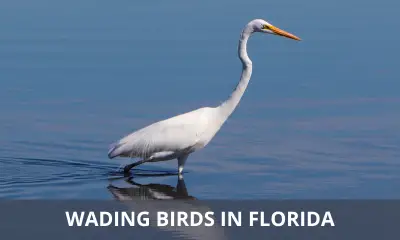
What are the types of wading birds in Florida?
There are 25 types of wading birds that can be encountered in Florida, which are described in full detail below.
Great Egret
Scientific name: Ardea alba
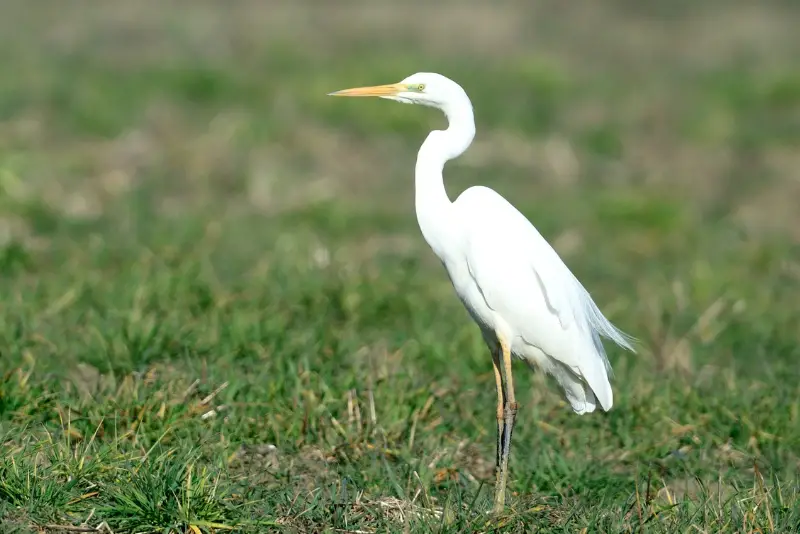
The Great Egret has a range that spans nearly the whole planet, and can be found on almost all continents.
These Florida wading birds have long legs and necks, as well as a long, yellow beak.
During the spring and summer breeding seasons, the Great Egret grows a plume on its back that extends all the way to the tip of its tail.
It lives in both saltwater and freshwater habitats, and often nests in large colonies on the shores of marshes, lakes, and rivers.
Great Egrets forage in any type of shallow water, including ponds, lakes, rivers, estuaries, as well as rice fields and other flooded areas in Florida.
Cattle Egret
Scientific name: Bubulcus ibis
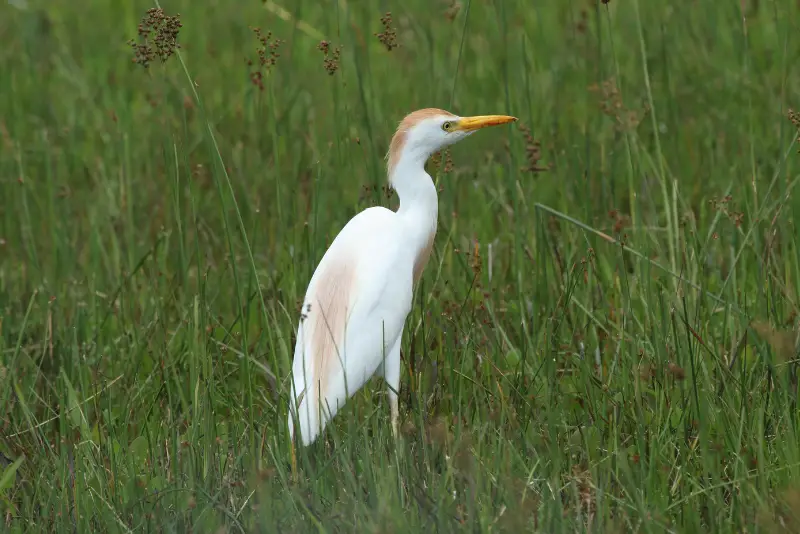
Smaller than Great Egrets, Cattle Egrets have shorter necks and are mostly white with streaks of brownish orange on the head, throat, and back.
The Cattle Egret is a relatively new species in the New World that originated in Europe and Africa.
Nobody knows how these herons crossed the Atlantic, but they were first discovered breeding in Brazil, and later in Florida, where these birds first appeared in late 1955.
Cattle Egrets have been very successful at colonizing the Americas, and are common breeding birds all over the southern states.
Snowy Egret
Scientific name: Egretta thula
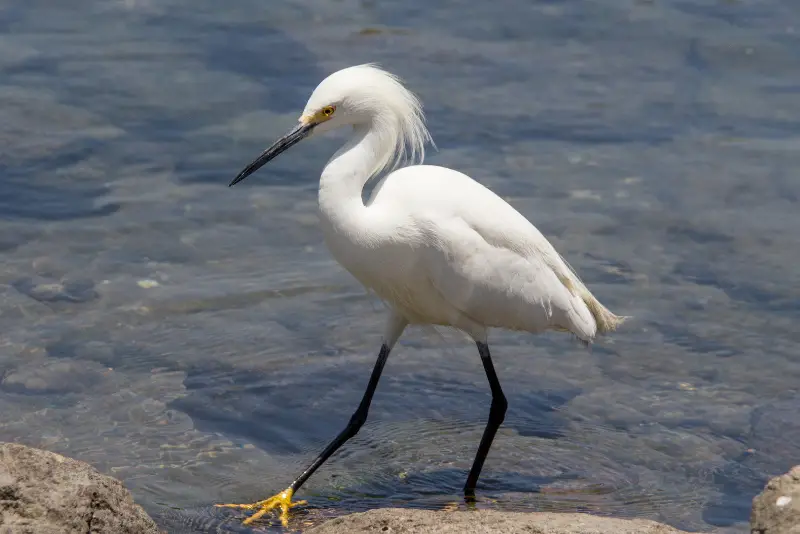
The Snowy Egret has become an increasingly common bird all over Florida.
This is due to aggressive conservation efforts that were necessary because this Egret species was systematically hunted in previous centuries.
In adult birds, the feet are a brilliant golden yellow, while their legs are totally black. It is thought that the brightly colored feet help to attract small fish and other prey.
The legs of juvenile birds are mostly greenish yellow, with some black areas on the front of the leg.
This Florida egret is found in practically all types of wetland environments, from small ponds to saltwater and everything in between.
Great Blue Heron
Scientific name: Ardea herodias
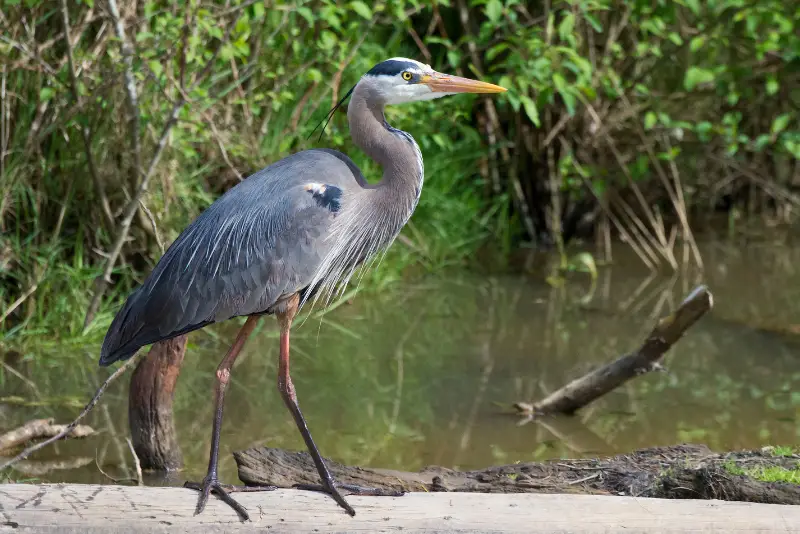
The Great Blue Heron is one of the most common herons found in Florida, where it can be seen year round.
With a wingspan of up to 6 feet, this heron is almost entirely blue gray, except for a white throat and eye stripe, as well as dark gray wing feathers.
The Great Blue Heron is the largest wading bird found in Florida
This enormous Florida bird likes to hunt for small mammals and fish by wading in the shallows of estuaries, mud flats and marshes along the seaboard.
Great Blue Herons can be found in many wetland habitats. You can find them in both saltwater and freshwater marshes, flooded fields, mangrove swamps, and lake shorelines.
This heron spends a lot of time standing motionless in shallow water, where it waits patiently for a suitably sized fish to come close enough to be grabbed with its long, yellow bill.
Green Heron
Scientific name: Butorides virescens
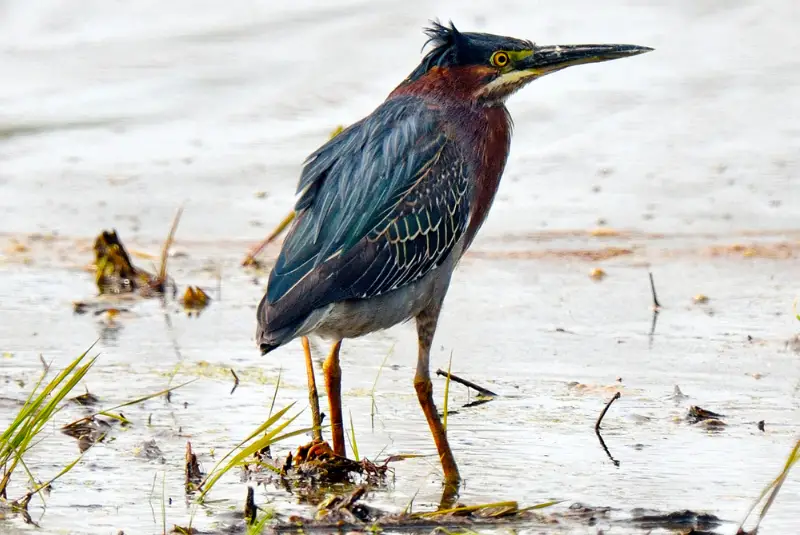
The Green Heron is a relatively common water bird in Florida. It’s a medium-sized heron with an olive-green body and black wings.
These Florida herons tend to live near water, so they’re often seen around lakes, rivers, ponds, or even swimming pools.
They eat fish, frogs, snails, small reptiles, amphibians, and crustaceans. They nest in trees or shrubs but sometimes build their nests on islands.
The Green Heron is usually silent except at dusk or dawn, when it makes its characteristic call, which sounds like “kreee.”
Little Blue Heron
Scientific name: Egretta caerulea
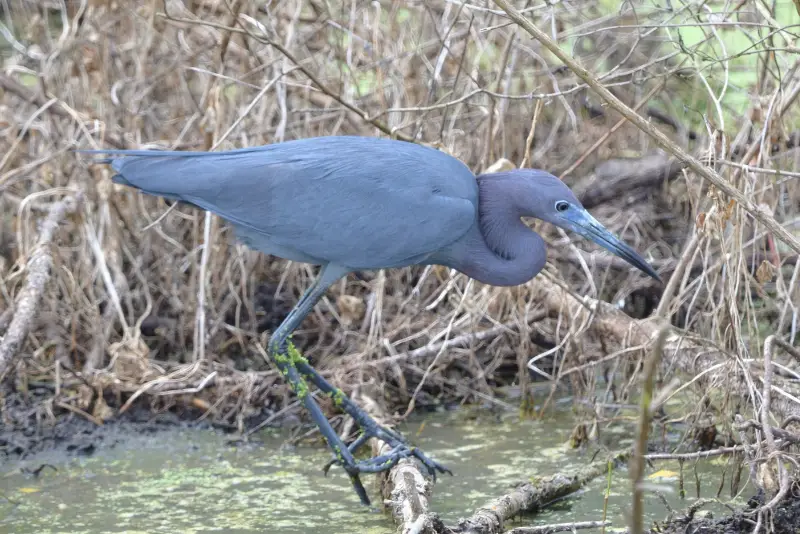
While adult Little Blue Herons are slate blue, young birds are entirely white during their first year.
Juvenile Little Blue Herons can be distinguished from other white herons in Florida by their dark bill and long green legs.
During winter, their numbers swell, due to an influx of birds from further north, which spend the winter months in Florida.
These small herons are relatively common birds of Florida that can be seen year-round. They feed on small fish, mollusks and crustaceans, with crayfish forming a large part of their diet.
Reddish Egret
Scientific name: Egretta rufescens
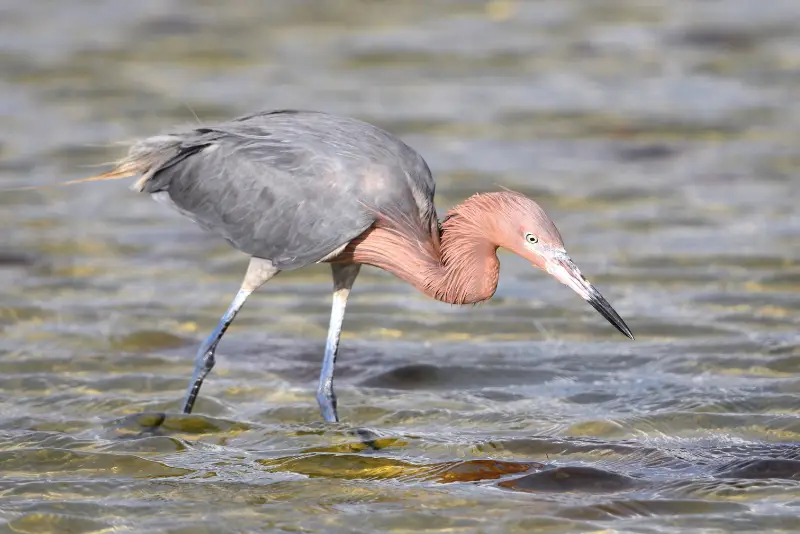
The Reddish Egret is a bird of shallow saltwater habitats in coastal areas of the Florida Gulf Coast, and the Florida Keys, where they are year-round residents.
These herons have an unusual foraging tactic when compared to other herons. They hunt for small fish on salt flats at low tide.
But instead of patiently waiting for fish to come within striking distance, Reddish Egrets pursue their prey by rapidly wading through shallow water, while waving their wings to startle small animals.
These small herons have a dark morph and a white morph. The best way to identify them is by their bi-colored bill, which is yellow at the base, and black at the tip.
Tricolored Heron
Scientific name: Egretta tricolor
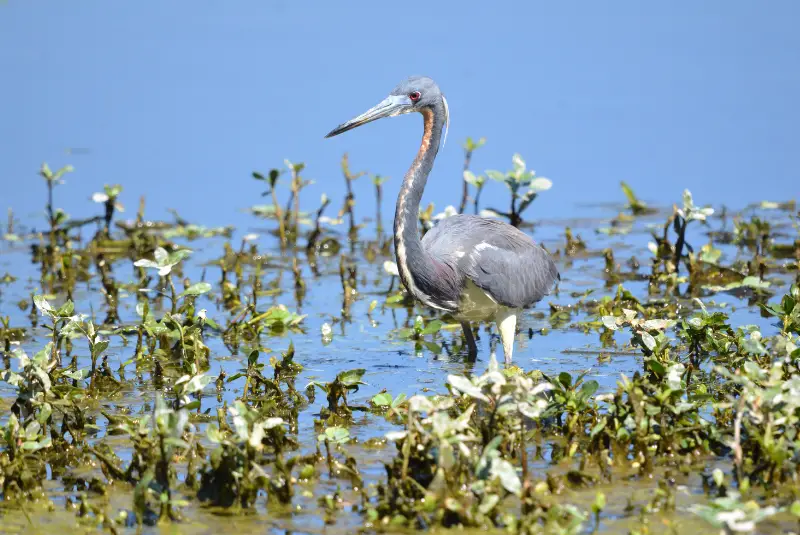
The Tricolored Heron used to be called the Louisiana Heron, and is a medium-sized wading bird with a blue-gray upper side and chest, as well as a white belly.
It is a regular breeding bird in Florida, where it is most often found in estuaries and salt water marshes along the Gulf Coast.
While Tricolored Herons like to nest in colonies, sometimes forming colonies with other heron species, they often forage alone and are fiercely protective of their territory.
They consume fish, crustaceans, amphibians, and insects, and will drive away other wading birds that invade their habitat.
This Florida shorebird hunts in shallow waters, usually by slowly wading or patiently waiting until its prey comes within reach.
American Bittern
Scientific name: Botaurus lentiginosus

American Bitterns are small herons that live in marshes and swamps, and are extremely well camouflaged to blend in with aquatic vegetation.
They can blend in with the reeds surrounding them thanks to their mottled brown patterning, as well as the way they hold their heads pointed upwards while remaining still amid the reeds.
Bitterns have a long neck that is similar in length to the rest of their body, which they use to catch small fish and other animals in shallow water.
Since these water birds are very secretive, the best way to identify a bittern is by its call, which sounds similar to “oonk-ka-oonk.”
Least Bittern
Scientific name: Ixobrychus exilis

The Least Bittern is hard to spot, since it usually remains hidden in dense reed beds. The best way to identify one of these herons is by its coo-coo-coo call.
If you do get your eyes on a Least Bittern, you’ll be pleasantly surprised by their attractive chestnut orange and black color.
The best places to see these herons are marshes and wetlands with dense vegetation, where they can be observed hunting at the edges of open water.
These bitterns are most active at dawn and at dusk, when they can also be seen flying to and from their roosting trees.
Roseate Spoonbill
Scientific name: Platalea Ajaja
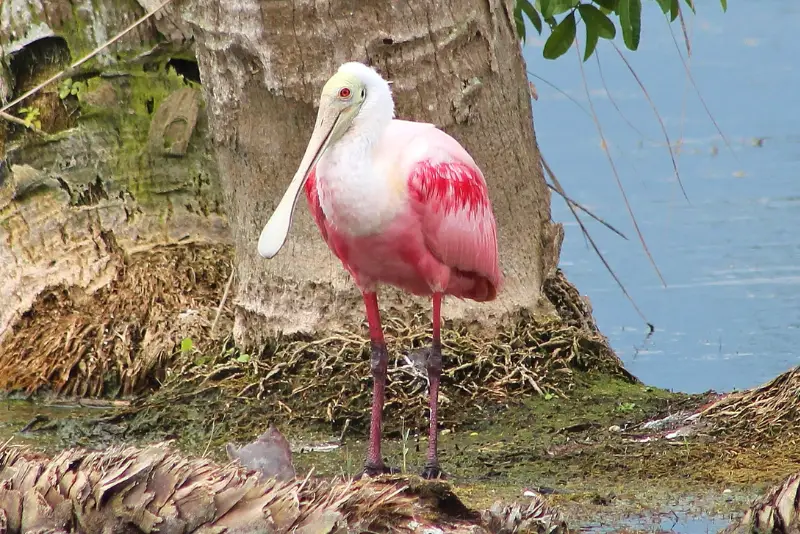
Roseate spoonbills are medium-sized wading birds in Florida, similar to storks but smaller, and can be readily recognized by their long spatula-shaped beak.
Adults are white on their backs, neck, and face, while the rest of their plumage is bright pink. However, it should be noted that the exact shade of pink can vary a lot, depending on its diet.
The more shrimp it eats, the more pink its plumage becomes, due to the carotenoid substances found in shrimp.
These pink birds of Florida are sometimes mistaken for flamingos as they look superficially similar, but keen ornithologists will notice that flamingos have a short, angled bill, while spoonbills have a long, spatulate bill that has a broad “spoon” at its end.
The best place to see these gorgeous birds in Florida is in the Everglades, which has more than 200 breeding pairs.
American Flamingo
Scientific name: Phoenicopterus ruber
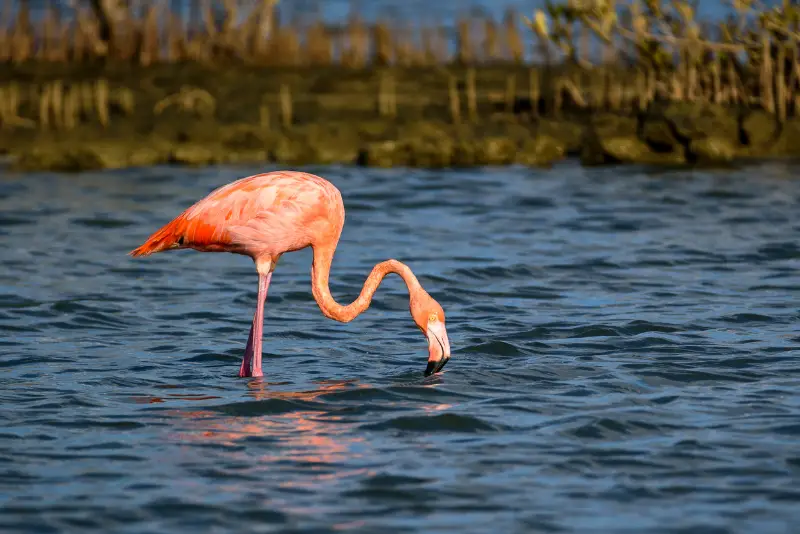
This Florida shorebird is a member of the flamingo family, Phoenicopteridae, that is found in North and South America.
When it comes to the sunshine state, no bird species is more synonymous with the culture of the state than the flamingo, which is somewhat ironic, given that it was not originally native to Florida.
Somewhat stereotypically associated with Miami, the American Flamingo is found along the coasts of the Caribbean, the Gulf of Mexico, as well as northern parts of South America.
It is thought that the population of American Flamingos is descended from birds that escaped from parks and zoos. It is most often seen in the Everglades and other areas with salt flats.
Whooping Crane
Scientific name: Grus americana
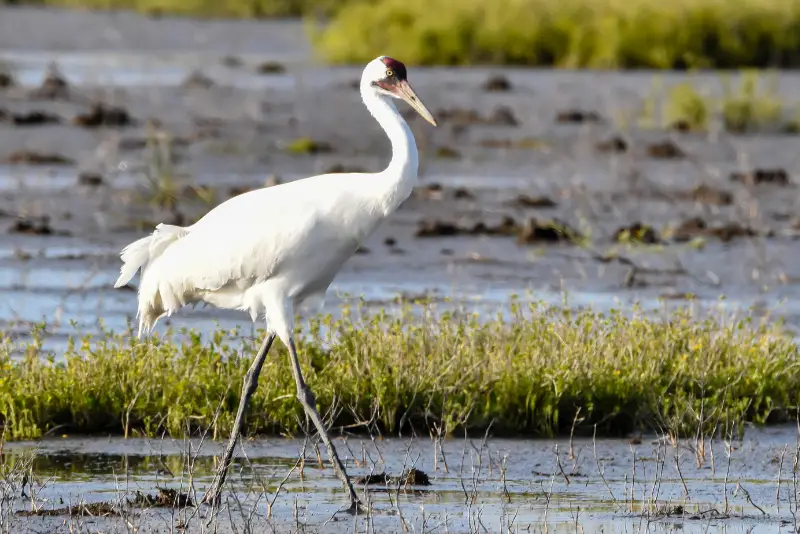
The Whooping Crane was almost at the edge of extinction in the 1930s, with less than 20 birds remaining.
However, sustained conservation efforts have brought it back to a current population that numbers 600 birds.
Adult Whooping Cranes have a completely white body, with a red cap that consists of bare skin. In contrast to adults, juvenile birds have a reddish brown color.
Whooping Cranes are only found in Florida during the cold season, wintering in the Sunshine State. They breed in Alberta, Canada, and migrate long distances south to spend the winter.
During the non-breeding season, the preferred habitat of Whooping Cranes are marshes, estuaries, and salt flats.
While the population of Whooping Cranes has made an amazing comeback from the edge of extinction, it is still a critically endangered species, and in need of continued conservation efforts.
Wood Stork
Scientific name: Mycteria americana
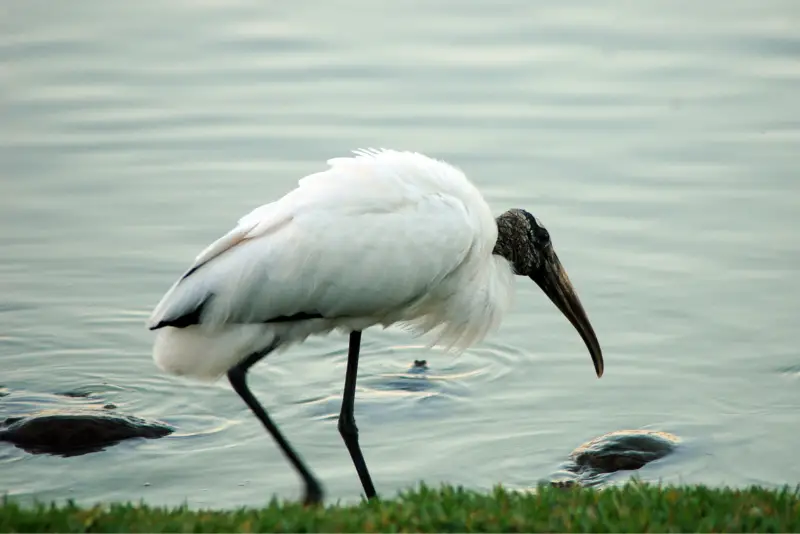
It’s easy to identify a Wood Stork if you can see it up close, due to its entirely white body combined with a bald, black head, and long black legs.
Similar to the White Ibis, the Wood Stork has a bill that curves slightly downwards. However, in contrast to the White Ibis, the Wood Stork has a black bill.
While the tail and wing tips are black, this is usually only apparent when you see a Wood Stork in flight.
The Wood Stork is a large bird, similar in size to a Great Egret, but is easily distinguishable from that species by its curved beak.
This wading bird feeds on frogs and other amphibians, fish, and aquatic invertebrates. It likes to nest in large colonies in old trees close to foraging areas.
White Ibis
Scientific name: Eudocimus albus
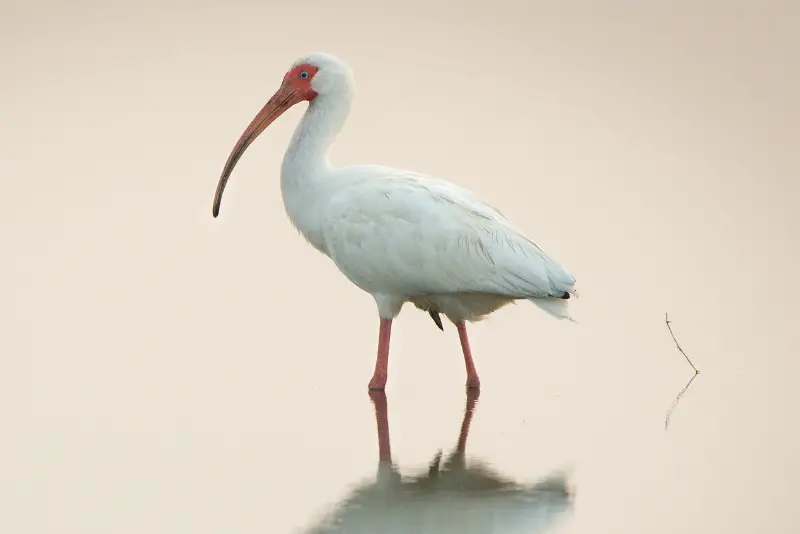
This white Florida bird with a long beak is easy to recognize due to its bright white plumage and extremely long orange beak that is curved downwards.
But keep in mind that during the first two years of their lives, immature White Ibises have a chocolate brown body with light streaks and a pale orange beak.
While the White Ibis is most commonly found in coastal areas of Florida, it prefers to forage in freshwater habitats.
These Florida birds feed on fish, insects, crayfish, and other crustaceans. They nest in large colonies in forests located close to wetlands.
White Ibises are extremely social birds, and like to forage in groups of 20 birds or more. In fact, it’s rare to see a solitary White Ibis.
Glossy Ibis
Scientific name: Plegadis falcinellus
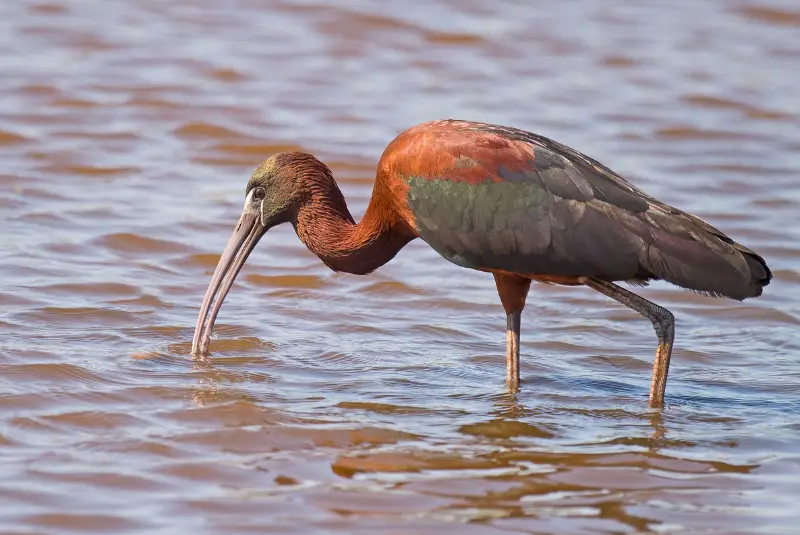
The Glossy Ibis is much darker than the aforementioned White Ibis, and viewed at a distance it looks uniformly dark brown.
But if you get a chance to view it up close in good light, you’ll notice that its plumage has glossy shimmers in many different colors, ranging from purple to green and violet.
The Glossy Ibis frequents freshwater habitats such marshes and shallow lakes, as well as saltwater lagoons and mangrove forests.
It is a regular breeding bird and year-round resident throughout Florida.
Limpkin
Scientific name: Aramus guarauna
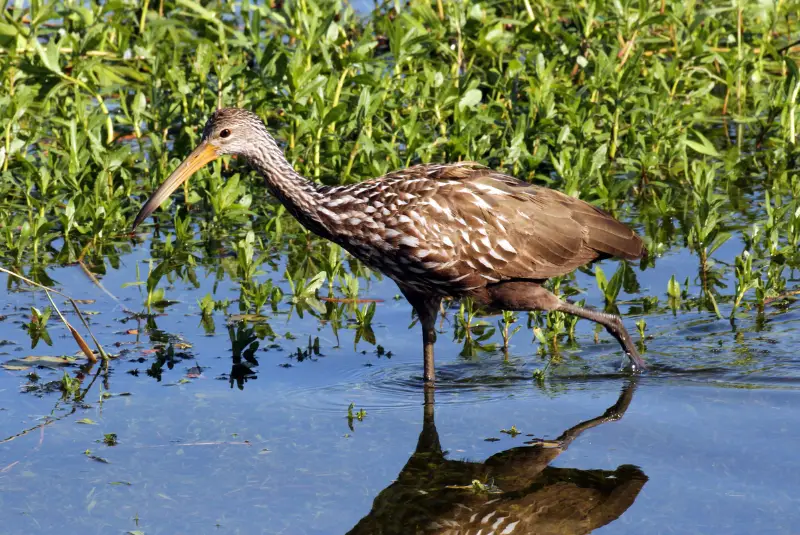
This large wading bird is a year-round resident throughout Florida, and can be encountered in a variety of wetland habitats.
Limpkins have a long thick beak, which they use to pry open the shells of mussels and other bivalves.
When they feel threatened or need to escape danger, they raise their head high into the air, creating the illusion of greater size and presence to deter predators.
Apart from their long bills, limpkins are known for their nocturnal calls, where they will cry out mournfully in the middle of the night.
Black-necked Stilt
Scientific name: Himantopus mexicanus

This wading bird is easy to identify by its striking black-and-white plumage coupled with long reddish pink legs, and a long thin beak.
Together with its characteristic black-and-white plumage, this makes it very easy to identify when you come across one in Florida.
With long orange legs that are more than 9 inches long, the Black-necked Stilt has the longest legs in proportion to its body size, compared to other birds.
This shorebird is a year-round resident in Florida. Its preferred breeding habitat are shallow marshes, but during the winter it is also found along the coast.
Short-billed Dowitcher
Scientific name: Limnodromus griseus
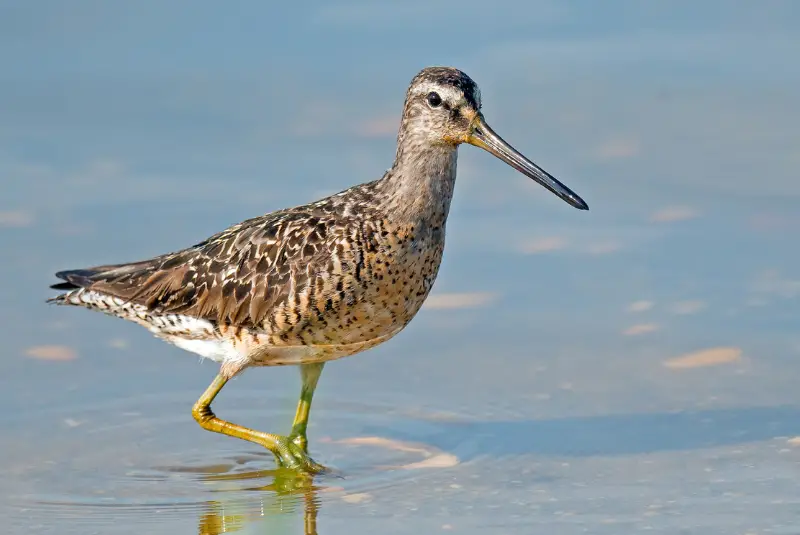
The Short-billed Dowitcher is a medium sized wading bird that is relatively easy to identify by its long legs and straight, dark bill.
It is a common year-round resident along the Florida coast, but is also found in freshwater habitats.
During the winter months it has a brownish-gray upperside, and white underside. During the breeding season, the throat and chest turn cinnamon orange.
This shore bird uses its long bill to probe for small invertebrates in muddy and sandy areas.
Black-bellied Plover
Scientific name: Pluvialis squatarola
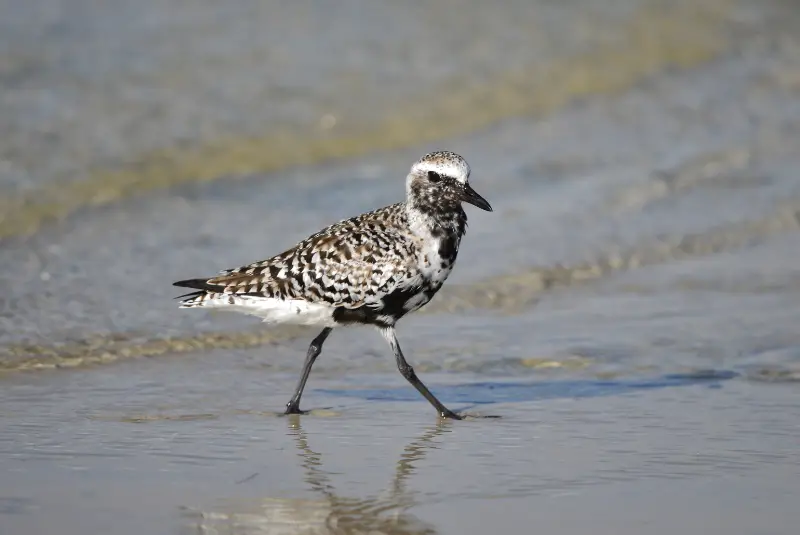
During the breeding season, the Black-bellied Plover is easy to identify by its striking black belly, breast, flanks, and face.
Outside of the breeding season, it is more drab, with white underparts and brown upperparts, and resembles a Sanderling in coloration.
However, it can be easily distinguished from a Sanderling by its much larger size.
This shorebird is a winter visitor to Florida beaches, where it can be seen from late July until April.
Long-billed Curlew
Scientific name: Numenius americanus
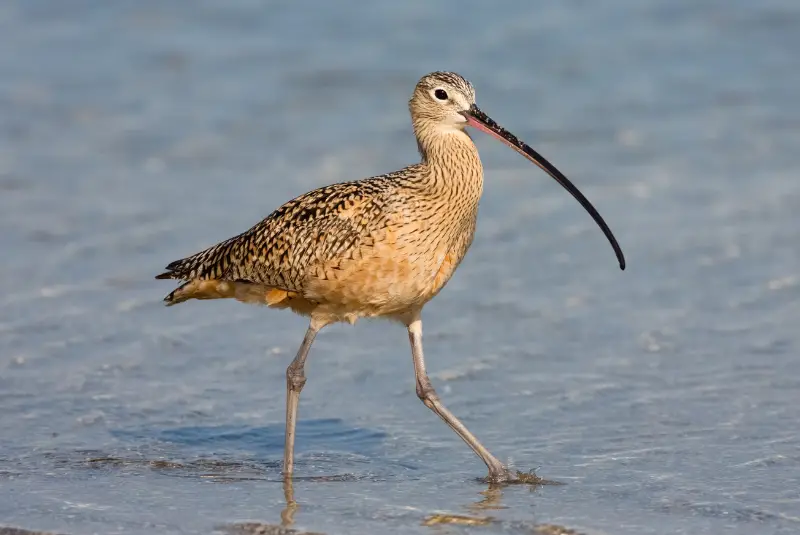
While the Long-billed Curlew is a breeding bird in the grasslands of the northwestern United States, it can be seen in Florida during winter from November through February.
This is the largest shore bird in Florida, and together with its extremely long, downturned beak, this makes it easy to identify when you see one.
Long-billed Curlews frequent mudflats, beaches, estuaries and flooded areas of Florida, where they use their long bill to probe the ground for worms and other invertebrates.
Spotted Sandpiper
Scientific name: Actitis macularius
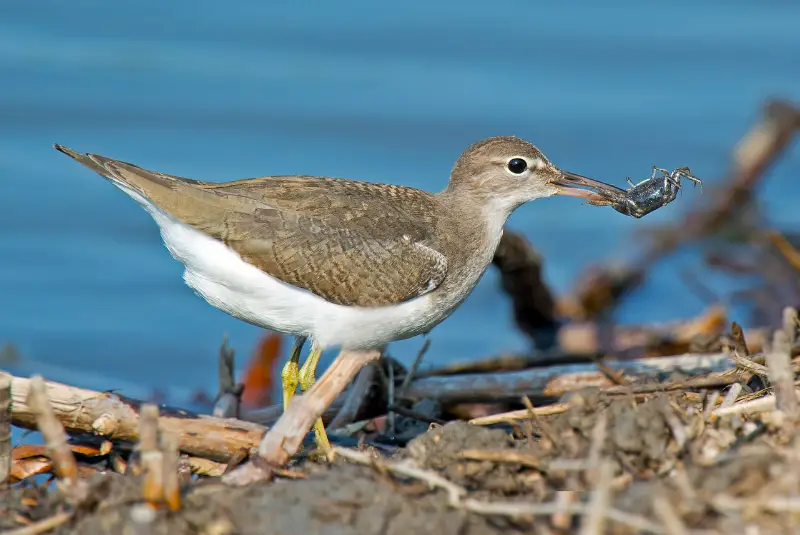
The Spotted Sandpiper is a common wintering bird in Florida, where it can be found on the edges of creeks and estuaries, as well as in freshwater habitats.
During the winter this wading bird has a brownish gray upperside, which contrasts with its bright white underside. A great way to identify it is by its constant bobbing of the tail.
This Florida sandpiper forages on banksides and muddy areas, where it picks up small insects and invertebrates from the ground.
Willet
Scientific name: Tringa semipalmata
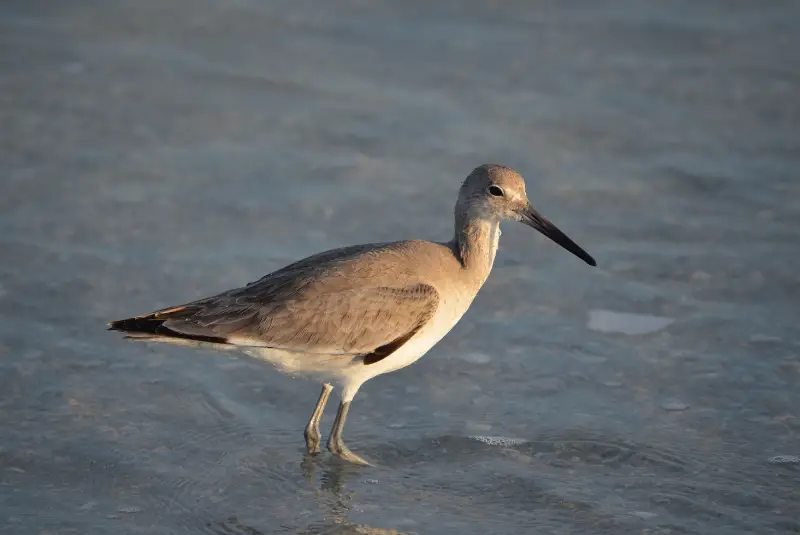
The Willet is common along the coast of Florida during the winter, but is also a year-round breeding bird in northern areas of Florida.
It is a medium sized wading bird with a brown upper side and a white underside. It is a beach bird that only occurs in saltwater habitats.
When it takes to the wing, its conspicuous black-and-white wing markings become visible. It forages for small aquatic insects, worms, crabs, and other invertebrates along the ocean shore.
Whimbrel
Scientific name: Numenius phaeopus
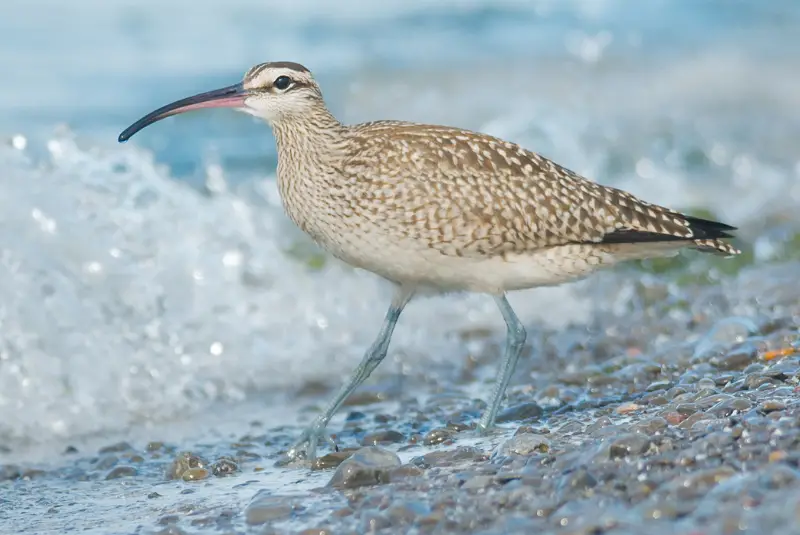
The Whimbrel is another large wading bird with a long downturned beak, and looks superficially similar to a Curlew, but is smaller than the latter and has a slightly shorter beak.
These birds breed in the arctic tundra, but can be observed along the Florida coast as rare winter visitors.
Whimbrels frequent mudflats, tidal estuaries, and saltmarshes, where their main food source consists of small crabs and other crustaceans.
American Oystercatcher
Scientific name: Haematopus palliatus
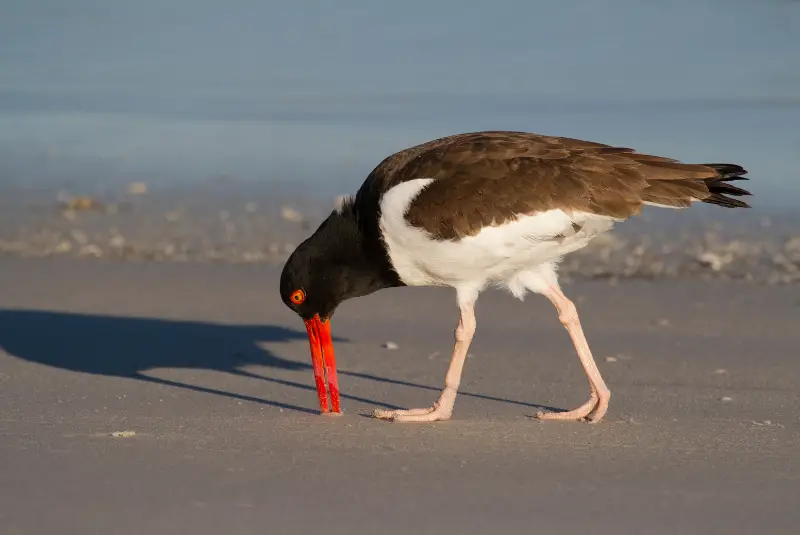
American Oystercatchers are beautiful beach birds with striking coloration. They have a jet black head and neck, which contrasts with a bright white belly and a long, heavy red bill.
The Oystercatcher is a bird of the tidal flats, where it follows the tidal patterns to feed on shellfish during low tide.
The heavy bill of the Oystercatcher helps it to pry open the shells of mollusks, and it also serves for hammering their shell until it shatters.
It is a year-round resident along the entire coast, inhabiting the tidal flats and beaches of Florida.
American Avocet
Scientific name: Recurvirostra americana
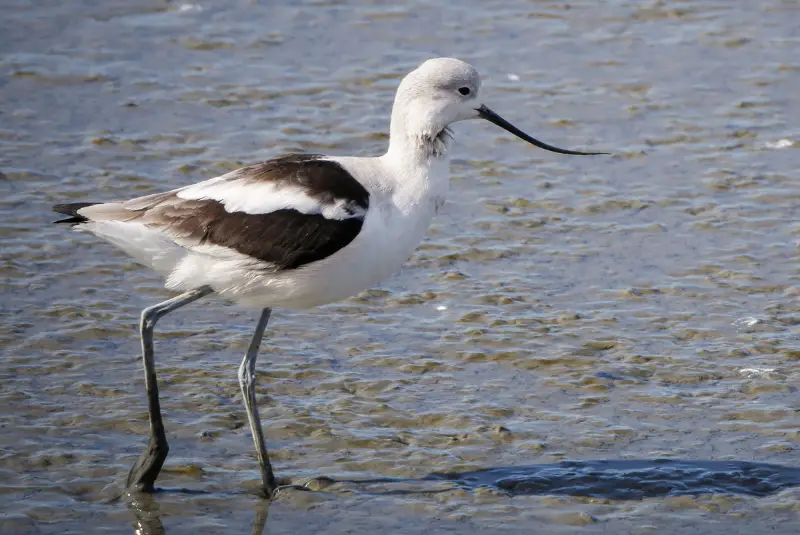
The American Avocet is another wading bird that doesn’t breed in Florida, but can be found wintering along the coast of Florida.
These elegant shore birds have a long bill that is unusual in that it is curved upwards, which makes it unique among all the birds on this list.
American Avocets are often encountered together with Black-necked Stilts at coastal lagoons and mudflats in Florida.
Final remarks
In summary, here are the 25 types of Florida wading birds:
- Great Egret
- Cattle Egret
- Snowy Egret
- Great Blue Heron
- Green Heron
- Little Blue Heron
- Reddish Egret
- Tricolored Heron
- American Bittern
- Least Bittern
- Roseate Spoonbill
- American Flamingo
- Whooping Crane
- Wood Stork
- White Ibis
- Glossy Ibis
- Limpkin
- Black-necked Stilt
- Short-billed Dowitcher
- Black-bellied Plover
- Long-billed Curlew
- Willet
- Whimbrel
- American Oystercatcher
- American Avocet
If you’ve spotted one of these waders while bird watching in Florida, but aren’t sure which species of bird it was, check our detailed ID guide with photos above.
If you enjoyed this article, check out our guide to the raptors of Florida.
